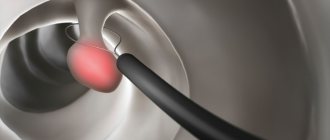Laboratory and clinical testing of diastase in the blood is prescribed at the Sensitive LCC in Yeysk, mainly for diseases of the gastrointestinal tract.
Diastase is a pancreatic enzyme involved in digestion. This enzyme enters the duodenum as part of pancreatic juice, and diastase is broken down into complex carbohydrates in the intestine.
If the pancreas is healthy, the concentration of diastase is always at a small but constant level. But if there are changes in the functioning of the organ, then the level of diastase also changes.
What is diastasis?
The enzyme alpha-amylase or diastase is produced by the pancreas, takes an active part in the functioning of the digestive organs and is involved in food processing. Amylase is part of pancreatic juice.
The process of carbohydrate breakdown occurs in the duodenum. Diastasis is within standard limits in the healthy body of any person.
If the main organ of the endocrine system does not have pathologies, then the concentration of amylase is at a constant level. Changes in diastase saturation indicate disorders in the body. An increased level of amylase is a consequence of pathology of the endocrine and digestive organs.
Normal for adults and children
To measure the content of this enzyme, a coefficient per liter of blood is used.
The enzyme content index changes during different life periods. And the patient’s age is of great importance for the diagnostic result.
The standard values for the diastase enzyme in the male body and the standard levels for the enzyme in the female body are the same. The female body is resistant to pancreatic disorders.
Table of normative indicators of amylase in the blood during different life periods:
| age | norm in units/l |
| newborns up to 12 months | no more than 8 units/l |
| from one year to ten years | about 30 units/l |
| from ten years to eighteen years | no more than 40 units/l |
| adults up to 70 years old | up to 125 units/l |
| older than 70 years old | up to 160 nd/l |
In women, while carrying a child, the diastase index does not change and corresponds to the coefficient that was before pregnancy. An increase or decrease in the enzyme indicates that there may be pathologies in the digestive organs.
There is also a fluctuation in amylase, which is temporary and occurs after the operation. The density of the enzyme in the blood can change after constant overeating.
The indicator in children should be within the corridor of up to 40 units/l. If the numbers reach an index of 100 units/l, then we can confidently talk about pathology in the body.
Diastasis - what is it?
To determine what this concept means, you must first understand the structure of the abdominal muscles. In the middle of the abdomen is the rectus muscle, which starts at the bottom of the abdominal cavity and ends at the pubic bone. The muscle consists of 2 parts, connected in the middle by loose connective tissue called the linea alba.
See more “before” and “after” photos
With prolonged and severe muscle tension, the pressure inside the abdominal cavity increases. The weakened tissues of the white line are not able to bear the load and move apart. At the same time, the distance between the parts of the rectus muscle increases; they move away from each other to the sides at a distance of a couple of centimeters. A kind of groove is formed, and with muscular effort the abdomen becomes convex in an unnatural way. Such a separation can form under the navel or above it, and can also be of a mixed nature.
It is necessary to distinguish between diastasis of the rectus abdominis muscle and hernia of the white line and umbilical protrusion. The discrepancy of the muscles does not cause compression of the organs, but outwardly it looks unaesthetic, especially since diastasis is most often detected in females.
According to the degree of discrepancy and the size of the resulting distance, diastasis is divided into three degrees:
- first - 2.5-5 cm;
- second - 5-8 cm;
- third - over 8 cm.
This classification makes it possible to find out the degree of muscle divergence, including independently.
Diastasis can also affect other muscle formations of the anterior abdominal zone. Depending on which tissues are included in the process, muscle divergence can be of four types:
- A - usual type of diastasis with divergence of only the rectus muscle;
- B - loss of tone in the inferolateral muscle areas;
- C - formation of discrepancy in the area of the xiphoid process and ribs;
- D - waist deformity.
How is a diastasis study performed?
To diagnose diastasis, only blood from a vein is needed.
In order for the test rate to be as accurate as possible, it is necessary to prepare for this procedure and follow the rules for donating blood for testing:
- Biological fluid is collected in the morning,
- The procedure takes place on an empty stomach,
- 5-7 calendar days before submitting biological fluid for analysis, it is advisable not to eat fatty foods, sour and smoked foods, pickled vegetables and sweets, and not to take medications,
- Do not smoke 4 hours before the procedure,
- Do not drink alcoholic or low-alcohol drinks for two days,
- If you are taking vital medications, inform your doctor.
The methodology of this study is not complicated: carbohydrates are added to the blood and the process of breaking down these carbohydrates by the enzyme amylase is monitored. The effectiveness of the enzyme is determined by the time of cleavage and is reflected in the blood test.
Reasons for increasing the diastase index
A mandatory biochemical blood test for amylase is necessary when diagnosing pancreatitis in the acute form of the disease, as well as chronic pancreatitis and at the time of relapse of the disease.
An elevated enzyme level indicates problems in the main organ of the endocrine system, as well as the digestive organs.
Reasons for elevated amylase levels in the blood:
- Pancreatitis is an acute form of inflammation of an organ or a chronic inflammatory process. During the period of inflammation, the function of the pancreas is disrupted, the outflow of pancreatic juice is difficult, which contributes to its accumulation in the organ. Because of this, its concentration increases,
- Oncological neoplasms in the endocrine organ . The secretion of the enzyme increases, which contributes to the accumulation of diastase in the blood and urine. If the neoplasm is localized in the organ itself, then the level of diastase will be maximum,
- Gallstones. When stones migrate into the bile ducts, difficulty occurs in the process of outflow of pancreatic juice and in this case, diastasis is increased,
- Renal failure in the acute form of the disease and in the chronic stage of the disease. The enzyme is excreted from the body with the assistance of the kidneys. Any deviation from the norm in the functioning of this organ leads to the accumulation of amylase in the body,
- Inflammatory process in the abdominal cavity peritonitis . Any inflammation negatively affects the functionality of internal organs. The pancreas suffers from inflammation in the peritoneum and disorders occur in it that provoke increased production of amylase,
- Hyperglycemia (diabetes mellitus) is a disease of the body that is directly related to disturbances in the carbohydrate metabolic process. With this pathology, not all amylase is consumed in the breakdown, a small part of it accumulates in the body and this causes an increase in its level,
- Mumps is an inflammatory process in the parotid gland, which is responsible for the production of saliva. Diastase is produced by the pancreas, and the salivary glands also take part in the process of its production. With mumps, an increase in diastase occurs.
Diastasis increases with pancreatic disease
For any diseases of the pancreas, the diastase coefficient will be increased. The results of a diagnostic study either confirm pancreatitis, or, according to tests, there is no inflammation in the pancreas.
What is urinary diastasis? Why is analysis needed and what is the standard indicator?
Diastase in urine is a special enzyme, which in urology is also called “alpha-amylase enzyme”. It is produced by the pancreas, promoting the breakdown of starch and various polysaccharides into simple, easily digestible types of sugars.
Based on the results of a urine test for diastasis, it is possible to detect serious pancreatic dysfunction, and promptly take all necessary measures to prevent dangerous consequences that can provoke the diagnosed pathologies.
What is alpha amylase and how does it affect human health? How to take urine tests correctly in order to get reliable laboratory results? For the sake of their own safety, every person who cares about the normal functioning of their body should know about this.
Normal urine diastasis and reasons for its increase
Knowing what urine diastasis is, every person should understand why its significant increase is dangerous, as well as why it occurs. There are several reasons why alpha-amylase exceeds the permissible limit in urine. Among them, the most common are:
- development of pancreatic diseases;
- diseases of the kidneys and urinary system;
- disruptions in the functioning of the biliary tract;
- acute appendicitis;
- peritonitis;
- pancreas cancer;
- diabetes;
- inflammatory processes occurring in the prostate;
- excessive production of enzyme by the pancreas, etc.
In some cases, a urine test for diastase may show a significant decrease in the enzyme alpha amylase, which is due to:
- sclerotic disorders of the normal functioning of the pancreas;
- atrophy (death) of pancreatic tissue.
The rate of urine diastase in adults and children is different, so there is no need to panic when you see “suspicious” numbers on the form. Moreover, the amount of alpha amylase directly depends on the patient’s age. It means that:
- in people over 60 years of age, the concentration of alpha amylase in a urine test can exceed 124 units per 1 liter (as a rule, the content of this enzyme ranges from 24 units to 150 units per 1 liter of urine sample);
- the norm of urine diastase in adults (up to 60 years) is from 20-124 units/l;
- the norm of urine diastase in children is 16-64 units.
Note. Alpha amylase is completely absent in newborns. However, as they grow older, its content gradually reaches normal (in the absence of the pathologies described above).
It is important to remember that when determining the level of this enzyme in the urine, the gender of the patient does not play a role. Therefore, when it comes to the normal level of alpha amylase in men, you need to look at the indicators that are typical for all adults.
Danger indicators and emergency measures
Since the rate of diastase in urine in adults and small patients should not exceed the levels described above, numbers in clinical tests such as 128, 512, 1024 units should cause a person’s caution. What do these indicators say?
Diastasis 128 units - what is the diagnosis?
This level of urine diastase is observed in acute pancreatitis, as well as in the presence of inflammatory processes in the pancreas. Chronic pancreatitis, which is in the acute phase, may also occur.
Diastase - 512 units
Diastasis in human urine can be increased to 512 units in the presence of swelling of the tissues lining the pancreas. With this pathological process, the outflow of juice from the pancreas worsens, which is why it lingers in it.
Amylase – 1024 units
Such indicators are extremely dangerous and may indicate severe disturbances in the functioning of the life-sustaining system. At the same time, an increase in the concentration of alpha amylase can last for only a few days, while the disease can last much longer.
What can affect AA levels in urine?
Under certain conditions, the determination of alpha amylase in urine may be unreliable. As a rule, such fluctuations in results are caused by a number of certain factors, among which the main role is played by:
- taking medications based on codeine, diuretics, morphine, etc.;
- drinking alcohol immediately before the test;
- external influence on a urine sample (saliva contains a certain amount of amylase, so if the patient (even accidentally) sneezes or coughs on the collected material, the results of the study will be unreliable);
- period of bearing a child, etc.
Among other things, false results from clinical studies can result from a person’s ignorance of how to properly take a urine test for diastasis. Of course, the rules of this process are practically no different from how to prepare for a regular urine test, but they still need to be clarified.
Preparing for a urine test for the presence of the enzyme alpha amylase - diastase
Knowing how to collect urine for diastase, you can be completely confident in the authenticity of the results obtained. To do this, remember the following recommendations:
- Do not drink alcoholic beverages for 24 hours before the test.
- When taking medications, ask your doctor if you can continue treatment or if it is better to stop it for a while. The fact is that some groups of drugs, as mentioned earlier, can significantly influence the results of studies.
- To collect urine, you must use either a sterilized glass jar or a special container, which can be purchased at almost every pharmacy.
- Before you start collecting urine, talk to your doctor. You may have to give your urine directly at the clinic.
Based on what urine diastasis is and what effect its level has on the functioning of all organs and systems in the human body, we can draw a clear conclusion: if you monitor your health and regularly undergo medical examinations just for prevention, you will not miss the moment development of severe pathology. This, in turn, is the main guarantee of the full functioning of not only the pancreas, but also other organs that perform important functions for the life of every person.
Reasons for reducing the diastase ratio
When checking diastase, low amylase concentrations are rarely diagnosed. If there is a decrease in amylase concentration, then this indicates quite serious and severe diseases of the body.
Such diseases require long-term and complex therapy with surgical intervention:
- Growth of pancreatic tumor cells . When diagnosed with oncology, the pancreas can produce quite a lot of amylase or completely stop the synthesis of this enzyme,
- Necrosis of endocrine organ tissue. When diagnosed with necrosis, the main organ of the endocrine system is not able to produce diastase,
- The disease mucoviscytosis is a congenital disease. The activity of the endocrine glands is disrupted. This disease develops in the lungs and digestive organs, but the pancreas is most affected.
In order to establish an accurate diagnosis of pancreatic disease, a blood test for diastasis is not enough. It is necessary to conduct additional examination of the digestive organs and endocrine system. Conduct diagnostics using ultrasound.
The totality of all diagnostic results can either confirm the pathology in these organs or reject the alleged diagnosis.
If diastase indicators are within normal limits or have minor changes, then we can say that there are no disturbances in the functioning of the pancreas and internal digestive organs.
Deviations of the index from the norm become a reason for additional examination and establishment of the correct diagnosis.
Diagnosis of blood for diastasis
To diagnose blood for diastasis, venous blood is taken at the Sensitive LCC in Yeysk. For a more reliable analysis, a few days before blood sampling, you should avoid fatty and fried foods. You should also consult with your doctor about medications that you take regularly - some of them can distort the result of the diastase test. Alcohol should be avoided the day before the test, and smoking should be avoided for several hours.
Blood is donated in the morning on an empty stomach. After taking blood, carbohydrates are added to it, and they look at the speed at which they are broken down in the patient’s blood. The higher the diastase activity, the higher the rate of carbohydrate breakdown.









